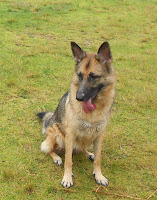An interesting case when pet sitting this week.
I was caring for a pair of dogs; Koda, a 3 year
old German Shepherd bitch, her older companion Bella and the family
cat, Jasper. When introduced to the
pets I noted Koda's obsessive behaviour around the cat - following
him, licking him, whining and pacing.
My assessment was there
was a specific event which had conditioned Koda to act this way as
every evening a 'ritual' kicked off. Jasper would announce his
arrival and demand to be let in by meowing continuously outside the
terrace doors until one of the family got up to let him in. He was
very persistent in this so someone would jump up the minute his
calling started. The cat would come in and Koda in turn would pant,
pace and whine – until the cat went out again.
The trouble is this was
not just once a night - it was repeated for the whole evening. Jasper
would meow to come in then demand to go out, cry to come back in, then
demand to go out again, and on and on the whole night. And just as the
family reacted to the cat's meow - so in turn Koda reacted by
starting her obsessive behaviour. The family would tell Koda to calm
down but that had no effect which meant evenings – or any time the
cat was around - were very unsettled.
The family had thought
Koda's obsessive behaviour around the cat was because she loved him.
In fact it was that Koda had become 'conditioned' by the cat's meow.
In her world the meow = her pack moving = she has to move too. But
she didn't know why she was moving and so was constantly confused and
anxious. This resulted in her obsessing over the cat until it went
out once more.
The irony is that it
wasn't really Jasper causing Koda's distress – it was the family's
reaction to Jasper's demands which made Koda repeatedly go into a
hyper state.
The way to solve this is
to deal with the root PROBLEM (family's reaction to the cat) rather
than SYMPTOM (Koda's distress). Telling Koda to be calm will never
work - if calm is wanted then that is what needs to be demonstrated.
Surprisingly it is relatively easy to
restore calm starts by letting Jasper know he can no longer dominate
the whole household! In future the cat meowing at the door had to be
COMPLETELY IGNORED. Not only should no one open the terrace door, but
the curtains should be closed (the cat would give up quicker if he
could not see anyone inside). Meanwhile Koda had to be encouraged to
lie quietly and not be allowed to pace even when the cat cried. And
only when Koda was calm should she be touched or praised.
3 habits are being broken
here:
- the cat's 'top dog' habit of getting everyone to wait on him by meowing
- the family's habit of jumping up to open the door the second the cat cried
- Koda's habit of pacing and moving on hearing the cat cry because she anticipated family/pack movement
For
a night or two the cat might continue to call, but once he fails to
get anyone to open the door he will learn if he wants to come in he
must use the rear of the house just like the rest of the pack.
Changing behaviour in this
simple way will get results otherwise:
'If you always do
what you've always done, then you'll always get what you always got'.












No comments:
New comments are not allowed.